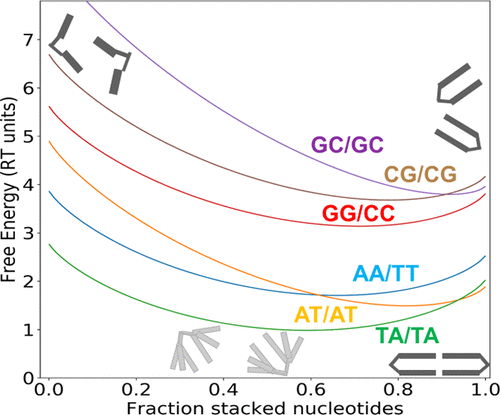当前位置:
X-MOL 学术
›
J. Phys. Chem. B
›
论文详情
Our official English website, www.x-mol.net, welcomes your
feedback! (Note: you will need to create a separate account there.)
Base-Pairing and Base-Stacking Contributions to Double-Stranded DNA Formation
The Journal of Physical Chemistry B ( IF 2.8 ) Pub Date : 2020-11-06 , DOI: 10.1021/acs.jpcb.0c07670 Martin Zacharias 1
The Journal of Physical Chemistry B ( IF 2.8 ) Pub Date : 2020-11-06 , DOI: 10.1021/acs.jpcb.0c07670 Martin Zacharias 1
Affiliation

|
Double-stranded (ds)DNA formation and dissociation are of fundamental biological importance. The negative DNA charge influences the dsDNA stability. However, the base pairing and the stacking between neighboring bases are responsible for the sequence-dependent stability of dsDNA. The stability of a dsDNA molecule can be estimated from empirical nearest-neighbor models based on contributions assigned to base-pair steps along the DNA and additional parameters because of DNA termini. In efforts to separate contributions, it has been concluded that base stacking dominates dsDNA stability, whereas base pairing contributes negligibly. Using a different model for dsDNA formation, we reanalyze dsDNA stability contributions and conclude that base stacking contributes already at the level of separate ssDNAs but that pairing contributions drive the dsDNA formation. The theoretical model also predicts that stability contributions of base-pair steps that contain only guanine/cytosine, mixed steps, and steps with only adenine/thymine follow the order 6:5:4, respectively, as expected based on the formed hydrogen bonds. The model is fully consistent with the available stacking data and the nearest-neighbor dsDNA parameters. It allows assigning a narrowly distributed value for the effective free energy contribution per formed hydrogen bond during dsDNA formation of −0.72 kcal·mol–1 based entirely on the experimental data.
中文翻译:

碱基配对和碱基堆积对双链DNA形成的贡献
双链(ds)DNA的形成和解离具有重要的生物学意义。DNA负电荷会影响dsDNA的稳定性。但是,碱基配对和相邻碱基之间的堆积负责dsDNA的序列依赖性稳定性。dsDNA分子的稳定性可以根据与DNA碱基对步骤有关的贡献以及由于DNA末端产生的其他参数,根据经验最接近的邻居模型进行估算。在分离贡献的努力中,已经得出结论,碱基堆叠支配dsDNA的稳定性,而碱基配对的贡献可忽略不计。使用不同的dsDNA形成模型,我们重新分析了dsDNA的稳定性贡献,并得出结论,碱基堆积已经在单独的ssDNA的水平上做出了贡献,但是配对的贡献推动了dsDNA的形成。该理论模型还预测,仅基于鸟嘌呤/胞嘧啶的碱基对步骤,混合步骤和仅具有腺嘌呤/胸腺嘧啶的步骤对的稳定性贡献分别遵循6:5:4的顺序,这是基于形成的氢键所预期的。该模型与可用的堆叠数据和最近的dsDNA参数完全一致。它允许为dsDNA形成过程中每个形成的氢键的有效自由能贡献分配一个狭窄的值-0.72 kcal·mol 根据形成的氢键的预期,仅使用腺嘌呤/胸腺嘧啶的步骤和仅使用腺嘌呤/胸腺嘧啶的步骤分别遵循6:5:4的顺序。该模型与可用的堆叠数据和最近的dsDNA参数完全一致。它允许为dsDNA形成过程中每个形成的氢键的有效自由能贡献分配一个狭窄的值-0.72 kcal·mol 根据形成的氢键的预期,仅使用腺嘌呤/胸腺嘧啶的步骤和仅使用腺嘌呤/胸腺嘧啶的步骤分别遵循6:5:4的顺序。该模型与可用的堆叠数据和最近的dsDNA参数完全一致。它允许为dsDNA形成过程中每个形成的氢键的有效自由能贡献分配一个狭窄的值-0.72 kcal·mol–1完全基于实验数据。
更新日期:2020-11-19
中文翻译:

碱基配对和碱基堆积对双链DNA形成的贡献
双链(ds)DNA的形成和解离具有重要的生物学意义。DNA负电荷会影响dsDNA的稳定性。但是,碱基配对和相邻碱基之间的堆积负责dsDNA的序列依赖性稳定性。dsDNA分子的稳定性可以根据与DNA碱基对步骤有关的贡献以及由于DNA末端产生的其他参数,根据经验最接近的邻居模型进行估算。在分离贡献的努力中,已经得出结论,碱基堆叠支配dsDNA的稳定性,而碱基配对的贡献可忽略不计。使用不同的dsDNA形成模型,我们重新分析了dsDNA的稳定性贡献,并得出结论,碱基堆积已经在单独的ssDNA的水平上做出了贡献,但是配对的贡献推动了dsDNA的形成。该理论模型还预测,仅基于鸟嘌呤/胞嘧啶的碱基对步骤,混合步骤和仅具有腺嘌呤/胸腺嘧啶的步骤对的稳定性贡献分别遵循6:5:4的顺序,这是基于形成的氢键所预期的。该模型与可用的堆叠数据和最近的dsDNA参数完全一致。它允许为dsDNA形成过程中每个形成的氢键的有效自由能贡献分配一个狭窄的值-0.72 kcal·mol 根据形成的氢键的预期,仅使用腺嘌呤/胸腺嘧啶的步骤和仅使用腺嘌呤/胸腺嘧啶的步骤分别遵循6:5:4的顺序。该模型与可用的堆叠数据和最近的dsDNA参数完全一致。它允许为dsDNA形成过程中每个形成的氢键的有效自由能贡献分配一个狭窄的值-0.72 kcal·mol 根据形成的氢键的预期,仅使用腺嘌呤/胸腺嘧啶的步骤和仅使用腺嘌呤/胸腺嘧啶的步骤分别遵循6:5:4的顺序。该模型与可用的堆叠数据和最近的dsDNA参数完全一致。它允许为dsDNA形成过程中每个形成的氢键的有效自由能贡献分配一个狭窄的值-0.72 kcal·mol–1完全基于实验数据。











































 京公网安备 11010802027423号
京公网安备 11010802027423号